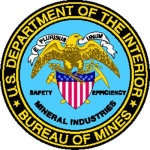- Branche: Mining
- Number of terms: 33118
- Number of blossaries: 0
- Company Profile:
The U.S. Bureau of Mines (USBM) was the primary United States Government agency conducting scientific research and disseminating information on the extraction, processing, use, and conservation of mineral resources.
Founded on May 16, 1910, through the Organic Act (Public Law 179), USBM's missions ...
A concretionary texture characterized by minute pellets of colloidal or replacement origin and closely resembling oolites.
Industry:Mining
A condition among underwater workers and mine rescue teams that is caused by ascending too quickly from deep dives.
Industry:Mining
A condition arrived at when driving pipe, casing, piling, etc., when it cannot be driven to a greater depth or made to penetrate the ground a distance of more than 1 ft (30.5 cm) per 100 blows delivered by a drive hammer.
Industry:Mining
A condition by which the furnace gives much less than the normal amount of iron at casting although the feeding may have been regular. The taphole runs iron slowly, and the amount of cinder is somewhat scanty. Compare: furnace losing-the-iron.
Industry:Mining
A condition encountered in some open-cut mines wherein the rock occasionally will not be broken down to grade because of an extra-hard streak of ground or because not enough explosive is used. This is called a "hard bottom"; it interferes with work and puts 1455 undue strain on a shovel. Such unbroken ores usually are drilled with a jackhammer and blasted.
Industry:Mining
A condition in which the space lattice of two related minerals is completely altered to a new type. This is illustrated by the quartz-tridymite relationship.
Industry:Mining
A condition in which there is no change in the geometrical symmetry of the crystal structure of two related minerals, but a change to permit a variant in the resultant mineral; e.g., orthoclase microcline. Compare: polytypy; polysyngony.
Industry:Mining
